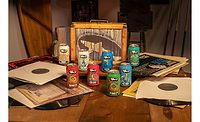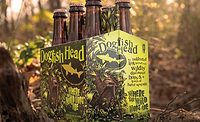Dogfish Head's ‘blissfully inefficient’ process

Dogfish Head Founder and President Sam Calagione discusses the changes planned for the expansion of its Milton, Del., facility.



The brewery’s current packaging line fills 240 bottles a minute and will be repurposed to a 750-ml. champage-style filling line once its 75,000 square-foot expansion is open next year. The new building will house a state-of-the-art filling line that will operate at speeds of 650 bottles a minute, the company says.






When Dogfish Head Craft Brewery opened its brewpub in 1995 in Rehoboth Beach, Del., Founder and President Sam Calagione brewed on a homemade machine dubbed “Sir Hops Alot.” To keep up with the restaurant’s demand, Calagione used “Sir Hops Alot” to brew two to three times a day, five to six days a week. Within a year, the brewpub’s traffic caused production to move to another homemade system made of 5-barrel tanks purchased from a local cannery factory auction.
Although do-it-yourself elements remain, today Dogfish Head’s Milton, Del., facility operates on a much larger scale. This year, the brewery expects to produce 170,000 barrels in its 100-barrel brewery. However, it projects another year of 20 percent growth, placing production in the 200,000 barrel range for 2013, which will reach the capacity of its existing facility.
Years of growth have kept the Milton facility in a state of constant flux, Calagione says. “It’s kind of always a construction site here at Dogfish because there’s always some part of the brewery that we’re improving,” he notes.
To increase its capacity, Dogfish Head also has a long-term plan to eventually become a 200-barrel brewhouse. Improvements have already begun at a rate that signals the brewery’s constant evolution, says Tim Hawn, Dogfish Head’s brewmaster.
“The place won’t look the same in 10 years,” Hawn explains. “We just replaced the burner core and 10 fermenters. If you came out next year, there will be even more tanks out front. We’ll take the wood tanks from where they are today and move them into a proper room.”
In addition to changes in the existing facility, Dogfish Head recently purchased property behind its facility for a 75,000 square-foot building to house its warehouse, merchandise, maintenance and packaging lines, explains Patrick Staggs, director of operations.
In June, the brewery will add another 10 brewing tanks, Calagione explains.
“With a 200-barrel brewhouse, our space, the new bottling line and everything new that we’re putting in here in the next few years, we can get to 500,000 or 600,000 barrels in the Milton facility,” he says. “After 2013, the only thing that we need to do that are the tanks that go inside. We’ll have a bottling line in the new brewhouse. We’re swallowing a lot of capital expenditure projects in the next 18 to 24 months, and then after that we’ll be able to slow down the spending, but keep up on the brewing growth.”
How it’s made
One element that is crucial to Dogfish Head’s production is its approach to ingredients. The company frequently goes to great lengths to allow Calagione’s inspirations to come to life, including pursuing regulatory approval for the Paraguayan palo santo wood used to build 10,000 gallon tanks to be used for an ingestible product, Calagione says.
“There’s nothing that we won’t pay for if we think it’s going to make a wonderful, distinct beer, and we’ll figure out a way to do it efficiently,” he explains. “The blissfully inefficient part is combing the entire culinary landscape for what we’re going to do; even if it means paying $20,000 in lawyer fees to liberate some Egyptian ingredients from a holding cell in Newark, N.J.”
The brewery maintains a similar steadfast loyalty to its brewing processes, which often include non-traditional elements, such as the brewing process for Ancient Ale Sah’tea, which is based on a 9th century Finnish recipe that adds white-hot rocks to boil the beer.
“Oftentimes, those things that are super-hard lead to the quality, and it’s also the things that are super-hard that lead to the complexity that probably informs why it hasn’t been done before,” Calagione says.
Staggs adds that although the ideas might be “blissfully inefficient,” the Dogfish Head team is dedicated to ensuring the entire process is not wasteful. The final number-crunching frequently falls to the company’s Chief Operating Officer Nick Benz, who determines how Dogfish Head can stay true to the recipe in a cost-efficient manner, Calagione says.
Dogfish Head’s dedication to quality follows into its plans for brewery improvements, Calagione explains. “We are so insanely dedicated that we don’t limit ourselves to the cost or source of ingredients, and we’re not limiting ourselves on the budget of the equipment,” he says.
Current capabilities
Dogfish Head’s Milton facility currently has the capacity to produce the company’s expected 170,000 barrels of beer this year. Presently, the facility runs three shifts on the hot-side of brewing and two shifts for packaging, Calagione says.
The facility’s layout separates the hot-side of brewing from the finished product tanks. Its bright beer cellar houses tanks for products that have finished fermenting, including beers that have been filtered and those that remain unfiltered, Calagione says. The bright beer cellar also features an organized network of pipes and a centralized command interface where brewers can control production.
Automation also helps connect the two sides of brewing through a set of pipes that use pneumatic valves to control flow from indoor and outdoor tanks. These technological advancements often contrast the “blissfully inefficient” brewing processes that the company follows, Calagione says.
“We’re still adding things like chai tea and wood-fired rocks in by hand, but then downstream of the hot-side of brewing we want to have a lot of sophisticated technology to assure quality and consistency,” he says. “… [The pipes have] pneumatic valves that you point-and-click on a computer screen and it opens up a tank or it transfers beer from one tank to another. Investing in this technology in the long-run brings quality and consistency, but it also brings great efficiency and scalability because when that next set of tanks come in, all we have to do is chop the end of this pipe-fence off and just continue welding the pipe-fence.”
The facility also includes barrels for storage of some of Dogfish Head’s more exotic beers, including Sah’tea, Red & White, Immort Ale and 120 Minute IPA, he explains. Because its portfolio includes 34 beers, Dogfish Head keeps packaging under certain restrictions, Calagione says.
“We try to make sure now that we keep our bottling line somewhat efficient, so even our lowest-selling brands will be about two or three of these inside tanks,” he says. “We try not to bottle anything that’s less than 500 to 600 barrels a year, even our one-off specialties, because you just end up frustrating customers if you send that little amount to the 24 states.”
Dogfish Head anticipates its 75,000 square-foot expansion will be operational by next year. The new building will house its new packaging line that will increase bottling speeds from 240 bottles a minute on its current line to 650 bottles a minute on the state-of-the-art line, Staggs says. The company plans to repurpose the current bottling line to run 750-ml. champagne-style bottles, Calagione notes.
Dogfish Head also operates a keg line, but Calagione says the brewery’s portfolio of higher intensity, flavored and exotic beers are sold more by the bottle than on draft in on-premise accounts. He estimates that draft represents at least 23 percent of Dogfish Head’s production.
The facility also operates a sophisticated air-handling system, Calagione says.
“[The units] pull the air in and the first thing that they do is they heat the air up so that it separates any moisture out of the air; then it goes through cleaning filter pads and then it goes through air conditioning,” he explains. “You can almost see how clean the air is in our facility. That is about a $600,000 investment and you can see there’s no mold anywhere in this facility or dust in the air because these systems do such an amazing job. That’s really important because particularly during the summer, we’re at the beach and it’s very humid here, and that humidity would breed mold or you’d get little tiny mold spots on the outside of the bottles as they sweat when they’re in [the warehouse].”
As it stands now, the company’s warehouse is able to house 10 to 12 days worth of inventory for the whole country, Calagione says.
Emphasis on quality
Because the brewery uses so many variations from traditional beer-making, Dogfish Head has a six-person quality control staff that runs every single batch through 42 checkpoints, Calagione says. One of the most frequent offenders during the fermenting process is the yeast, he explains.
“We often say the 140 [employees] sometimes get out-voted by the billions of yeast cells in our building,” Calagione says. “Sometimes a beer like 120 Minute IPA or Chateau Jiahu won’t ferment all the way. We’re monitoring that in here and usually we’re able to resuscitate the yeast in process … but occasionally we can’t.
“So we have a line item at Dogfish Head called dated and damaged goods that’s budgeted to be a six-figure number every year because we just know there are going to be some beers that aren’t going to meet our standards either on the microbiology side or the sensory side,” he continues. “We have to have the courage to just dump that because people are paying a premium and you want them to try it a second time. If it’s a little too sweet or a little too whatever, they probably won’t.”
The company also runs all batches past a sensory team that consists of trained Dogfish Head employees from various departments. Panelists test beers that are still fermenting as well as finished beers that are one day away from packaging and brand-new releases.
Special processes
Among Dogfish Head’s portfolio of 34 beers are a handful of wood-aged beers, such as Burton Baton, an oak-aged combination of imperial IPA and English strong ale, and Palo Santo Marron, an unfiltered brown ale aged in tanks made from imported Paraguayan wood. To create these beers, the Milton brewery uses three 10,000 gallon wood tanks, two made from oak and one from palo santo wood from Paraguay, Calagione says.
As part of its growth plans, the company is relocating its current wood barrels into a special space that has room to grow.
“We brew more wood-aged beer than any brewery in the country,” he says. “Because of that, we’re expanding our wood-aging program. We have two more tanks on order, one made out of the palo santo wood and one made out of oak.”
The facility also includes a separate room with a controlled environment for its bottle-conditioned beers, including My Antonia, an imperial pilsner-style lager. My Antonia is the only lager Dogfish Head produces and uses a bottom-fermenting process in which the beer is bottled in 750-ml. champagne-style bottles without any carbonation. The bottles are then dosed with yeast and extra sugar and then are placed in a temperature-controlled room. The room also houses fellow bottle-conditioned beers: Belgian-style white ale Namaste and cask-conditioned 75 Minute IPA that, similar to My Antonia, Namaste and 75 Minute IPA, need an additional three weeks in the controlled environment to naturally carbonate, Calagione says.
Its current space also has the capacity for a special area known as “Sam’s Stash,” where the company keeps one or two pallets of every beer that Dogfish Head produces that contains more than
9 percent alcohol by volume, which is the minimum for age-able beers, Calagione says. The section has been storing beers since 2000, which was when the company could finally afford to save inventory, he notes. The beers in Sam’s Stash include a selection of 2004 120 Minute IPA as well as the last four cases of its 2002 Festina Peche, an American wild ale.
Occasionally, the company will release its vintage beers by the case and for events at its Rehoboth Beach brewpub, Dogfish Alehouses in the Washington, D.C., area and well-known beer establishments in other cities.
“It’s a neat way for the consumer to buy maybe a brand new fresh 120 Minute IPA and then buy a 2004 120 Minute IPA, sit down and be like, ‘Wow, I can really see the difference,’” Calagione says. BI
Looking for a reprint of this article?
From high-res PDFs to custom plaques, order your copy today!











